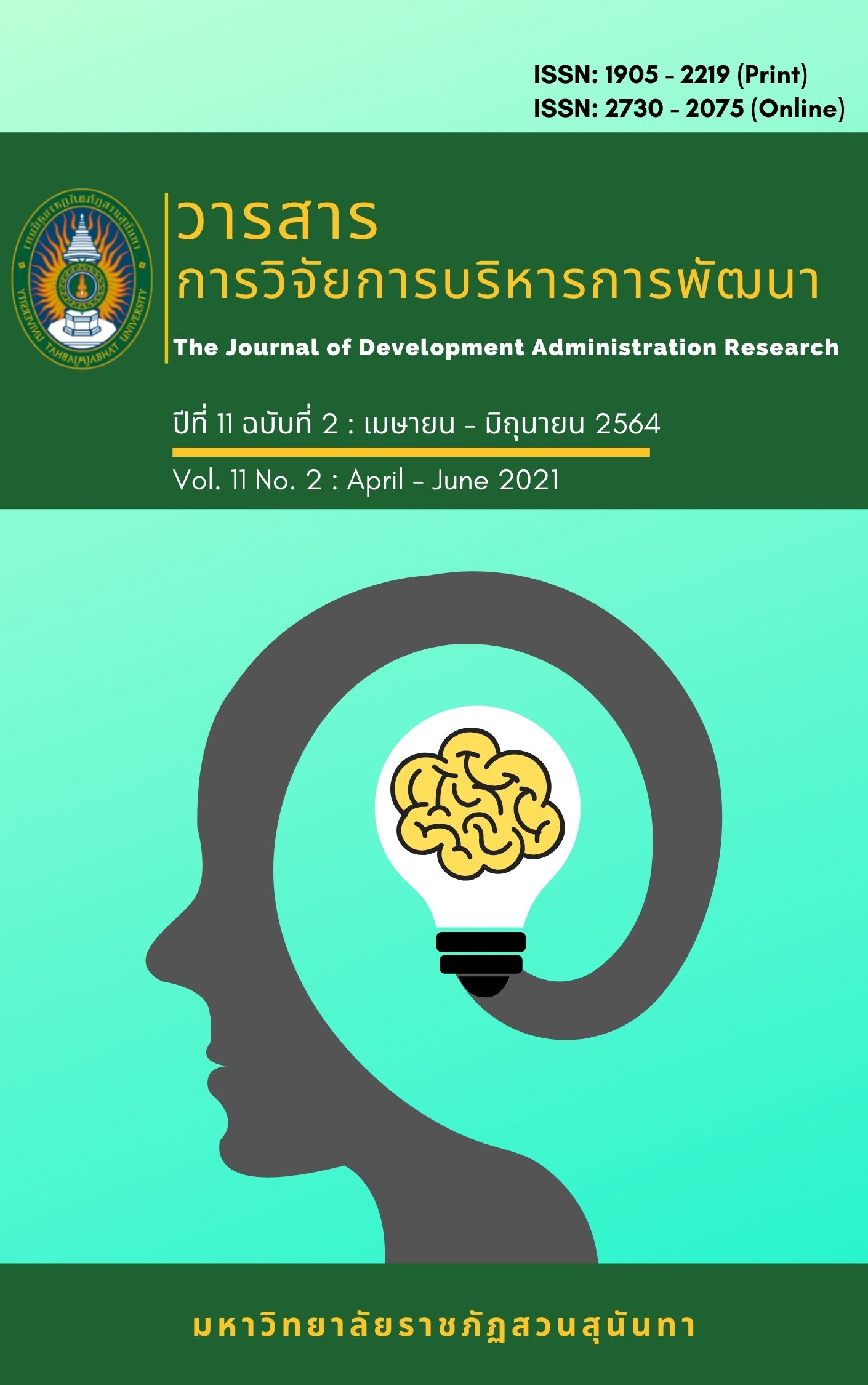กรอบการประเมิน: แนวทางใหม่แห่งการประเมิน
คำสำคัญ:
กรอบการประเมิน, แนวทางเกณฑ์และตัวบ่งชี้บทคัดย่อ
การประเมินเป็นกิจกรรมหนึ่งที่ได้มาซึ่งสารสนเทศเพื่อการตัดสินคุณค่าหรือตัดสินใจในผลการดำเนินงานที่เกิดขึ้นจากตัวชี้วัดผลการดำเนินงานที่สามารถสะท้อนคุณภาพ ความสำเร็จ ประสิทธิภาพ ประสิทธิผล และความพึงพอใจกับผลที่เกิดขึ้น สำหรับขั้นตอนในการประเมินผลการดำเนินงานควรเริ่มตั้งแต่การกำหนดวัตถุประสงค์ การศึกษาโครงสร้างหรือกระบวนการในการดำเนินงาน การกำหนดตัวชี้วัดและกำหนดมาตรฐานการดำเนินงาน แล้วนำมาเปรียบเทียบและตัดสินกับผลที่ได้รับ โดยการประเมินผลการดำเนินงานนั้นมีหลากหลายรูปแบบตามแต่ละทฤษฎีที่มีวิธีการแตกต่างกันออกไป กรอบการประเมินเป็นแนวทางใหม่ในการประเมินผลการดำเนินงานที่อาศัยระเบียบวิธีวิจัยผสานกับแนวทางเกณฑ์และตัวบ่งชี้ด้วยวิธีการแบบบนลงล่างและวิธีการแบบล่างขึ้นบนมาเป็นแนวทางในการพัฒนากรอบการประเมิน โครงสร้างของกรอบการประเมินมีลักษณะเป็นแบบลำดับชั้น ประกอบด้วย ชุดข้อมูล 4 ระดับ ได้แก่ ชุดข้อมูลของหลักการ เกณฑ์ ตัวบ่งชี้ และตัวตรวจสอบ เพื่อนำไปกำหนดมโนทัศน์ แนวทางปฏิบัติ การประเมิน และการติดตามที่สามารถนำไปปรับใช้ในแวดวงการศึกษา เศรษฐกิจ สังคม วัฒนธรรม การบริหารจัดการ การท่องเที่ยว ตลอดจนการจัดการสิ่งแวดล้อมและอื่น ๆ บทความนี้จึงมุ่งนำเสนอความรู้เบื้องต้นเกี่ยวกับแนวทางเกณฑ์และตัวบ่งชี้ แนวทางและระเบียบวิธีวิจัยในการพัฒนากรอบการประเมิน การประยุกต์แนวทางเกณฑ์และตัวบ่งชี้เพื่อพัฒนากรอบการประเมินในงานวิจัยต่าง ๆ รวมถึงความท้าทายและมุมมองจากประสบการณ์ในการพัฒนากรอบการประเมินของผู้เขียนเพื่อการวิจัยและพัฒนาในอนาคต
เอกสารอ้างอิง
ณัฐชัย วงศ์ศุภลักษณ์, พูลพงศ์ สุขสว่าง และกนก พานทอง. (2563). การพัฒนากรอบการประเมินการจัดการโซ่อุปทานการท่องเที่ยวเชิงสุขภาพสำหรับผู้ประกอบการกิจการสปาไทย. วารสารวิทยาลัยดุสิตธานี, 14(2), 121-140.
ศิริชัย กาญจนวาสี. (2552). ทฤษฎีการประเมิน (พิมพ์ครั้งที่ 7). กรุงเทพฯ: สำนักพิมพ์แห่งจุฬาลงกรณ์มหาวิทยาลัย.
Ashok, S., Tewari, H. R., Behera, M. D., & Majumdar, A. (2017). Development of Ecotourism sustainability assessment framework employing Delphi, C&I and participatory methods: A case study of KBR, West Sikkim, India. Tourism Management Perspectives, 21(5), 24-41.
Barbier, E. B. (1987). The concept of sustainable economic development. Environmental Conservation 14(2), 101–110.
Choi, H. C., & Sirakaya, E. (2006). Sustainability indicators for managing Community tourism.Tourism Management, 27(6), 1274-1289.
CIFOR. (1999). The CIFOR Criteria and Indicators Generic Template. Jakarta: AFTERHOURS.
Domingues, A. R., Pires, S. M., Caeiro, S., & Ramos, T. B. (2015). Defining criteria and indicators for a sustainability label of local public services. Ecological Indicators, 23(57), 452-464.
Edmonds, W. A., & Kennedy, T. D. (2017). An Applied Reference Guide to Research Designs: Quantitative, Qualitative, and Mixed Methods (2nd ed.). California: SAGE.
Giannarou, L. (2014). Using Delphi technique to build consensus in practice. International Journal of Business Science and Applied Management, 9(2), 65-82.
Khadka, C., & Vacik, H. (2012). Comparing a top-down and bottom-up approach in the identification of criteria and indicators for sustainable community forest management in Nepal. Forestry, 85(1), 145-158.
Kurka, T. & Blackwood, D. (2013). Participatory selection of sustainability criteria and indicators for bioenergy developments. Renewable and Sustainable Energy Reviews,24(16), 92-102.
Lammerts van Bueren, E. M., & Blom, E. M. (1997). Hierarchical framework for the formulation of sustainable forest management standards. Rotterdam: Veenman Drukkers.
Namkoong et al. (2002). Criteria and Indicators for Sustainable Forest Management: Assessment and Monitoring of Genetic Variation. Forest Genetic Resources Working Papers. Rome: Forestry Department.
Phondani, P. C., Bhatta, A., Elsarraga, E., & Alhorra, Y. M. (2016). Criteria and indicator approach of global sustainability assessment system for sustainable landscaping using native plants in Qatar. Ecological Indicators, 69(16), 381-389.
Pokorny, B., & Adams, M. (2003). What do criteria and indicators assess? An analysis of five C&I sets relevant for forest management in the Brazilian Amazon. International Forestry Review, 5(1), 20-28.
Prabhu, R., Colfer, C. J. P., Venkateswarlu, P., Tan, L. C., Soekmadi, R., & Wollenberg, E. (1996). Testing Criteria and Indicators for Sustainable Management of Forests: Final Report of Phase I. Jakatar: CIFOR.
Ritchie, B., McDougall, C., Haggith, M., & de Oliveira, N. B. (2000). Criteria and Indicators of Sustainability in Community Managed Forest Landscapes: An Introductory Guide. Jakarta: SMT Grafika Desa Putera.
Teitelbaum, S. (2014). Criteria and indicators for the assessment of community forestry outcomes: a comparative analysis from Canada. Journal of Environmental Management, 132(25), 257-267.
Twersky, F., & Lindblom, K. (2012).Evaluation Principles and Practices. Retrieved March,17, from https://www.hewlett.org/wp-content/uploads/2016/08/EvaluationPrinciples-FINAL.pdf
ดาวน์โหลด
เผยแพร่แล้ว
รูปแบบการอ้างอิง
ฉบับ
ประเภทบทความ
สัญญาอนุญาต
บทความที่ได้รับการตีพิมพ์เป็นลิขสิทธิ์ของมหาวิทยาลัยราชภัฏสวนสุนันทา
ข้อความที่ปรากฏในบทความแต่ละเรื่องในวารสารวิชาการเล่มนี้เป็นความคิดเห็นส่วนตัวของผู้เขียนแต่ละท่านไม่เกี่ยวข้องกับมหาวิทยาลัยราชภัฏสวนสุนันทา และคณาจารย์ท่านอื่นๆ ในมหาวิทยาลัยฯ แต่อย่างใด ความรับผิดชอบองค์ประกอบทั้งหมดของบทความแต่ละเรื่องเป็นของผู้เขียนแต่ละท่าน หากมีความผิดพลาดใดๆ ผู้เขียนแต่ละท่านจะรับผิดชอบบทความของตนเองแต่ผู้เดียว




